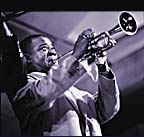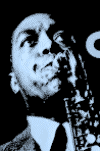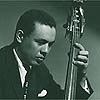
Louis
Armstrong
Photo: Herman Leonard
|
Jazz,
a new documentary by Ken Burns, is a celebration of a unique American
art form and of the people that made it. Miles Davis, Louis Armstrong,
John Coltrane, Duke Ellington, Charlie Parker, and Dizzy Gillespie—these
are the illustrious names that fill the history of jazz. Burns
begins at the beginning—in New Orleans—then traces jazz’ history
from Dixieland to Avant-Garde, from the East Coast to the West
Coast, from predictable ensembles to totally free improvising.
Jazz wants to re-introduce the viewer to this grand,
uniquely American art form; it wants to remind the viewer just
how special a Charles Mingus is; and it wants to remind the viewer
of the contributions and sacrifices that African Americans have
made to bring this music to the culture.
The
story of Jazz is told in ten parts, lasting a total
of 19 hours. Each section covers a time period, providing biographies
of important figures and covering social developments within that
time. Episode 1 titled, "Gumbo," explores the origins
of jazz in New Orleans. The most musical of American cities during
the 19th century, the viewer learns of cultural and
musical ingredients that went into the "gumbo" that
would become jazz. Jazz provides biographies of
notable artists like Louis Armstrong and Duke Ellington, which
are told over a number of episodes. This allows the viewer to
see the full career of these giants—not just the parts where they
were "in style." Jazz is also a social document, continually
reminding the viewer of the segregation and prejudice that have
been inflicted against African Americans within American society.

Charlie Parker |
There
are many highlights throughout the series. Episode 8, titled "Risk,"
covers the be-bop insurgency and the short, troubled career of
saxophonist Charlie Parker. Injured as a teenager in an automobile
accident, Parker seemed troubled for the remainder of his life.
Clips of Parker’s performances show what appears to be a totally
emotionless person, playing rapid, beautiful solos. Many musicians,
fascinated by Parker’s style, would also adopt his drug habit
(heroin) to emulate their hero. Parker’s sometime partner, Dizzy
Gillespie, would spread the gospel of bop, kindly sharing technique
and musical theory with young players. Many older players like
Armstrong thought bop was nonsense, and the swing audience surely
couldn’t dance to it. But by the time Parker had died in 1955,
jazz had entered the modern era with a completely new sheen.
Jazz
continually relates issues of race both heartening and harrowing.
Episode 3, "Our Language," tells the story of the Empress
of the Blues, Bessie Smith. While performing in a Southern local,
one of her musicians informed her that several members of the
Klan were descending upon the tent show. Smith, no pushover, stormed
out to meet them—shaking her fist. "I’ll get the whole damned
tent out here. You just pick up them sheets and run!" They
left. Other stories prove more disturbing. While performing in
a downtown club, Miles Davis decided to go outside during a break.
A white police officer asked him to move along. When Davis refused,
explaining that he was working at the club, the officer beat him
bloody. In 1957, Louis Armstrong had been asked by the State Department
to go on a goodwill tour of Russia. When Eisenhower did little
to stop the violence surrounding desegregation at Little Rock
Central High School, Armstrong refused to go on the tour.

Charles Mingus |
Jazz
will receive criticism on several accounts, but the criticism
will come from jazz critics and aficionados, not the general audience
Burns is aiming for. Some will view the series as musically conservative,
failing to explore the more adventurous styles of Avant-Garde
and Free Jazz. The ever-present Wynton Marsalis will reinforce
this feeling. Others will criticize the scant coverage of jazz
after 1961, with fusion only being mentioned in relation to Miles
Davis’ later work, and Charles Mingus only receiving a very short
biography. None of these points will probably bother the casual
fan or jazz novice. Besides, Jazz has so many strong
points, it would be a disservice to concentrate on these smaller
items.
Jazz
is an audacious undertaking that will successfully introduce jazz
and jazz history to the uninitiated, as well as teach jazz lovers
a thing or two. It is possible that every viewer will not want
to invest the 19 hours required to watch the entire series, but
that would be unfortunate. Though lengthy, Jazz
offers a chance to view the panorama of the music, and to see
how one movement fed into another. Jazz should also
leave the viewer much more aware of the evils of segregation,
and of the vast contribution of African-American artists like
Armstrong, Ellington, Parker, and Coltrane. Many viewers—like
this one—will undoubtedly want to go out and buy the music they’ve
heard while watching the series. If they do, then the series has
accomplished what it aimed for: inspiring Americans to listen
passionately and appreciate one of their culture’s crowning achievements.
Ronnie
D. Lankford, Jr.
[email protected]
Credits
Ken
Burns—Director/Producer/Cinematography
Lynn Novick--Producer
Geoffrey C. Ward—Screenwriter
Buddy Squires—Cinematography
Keith David—Narrator
Paul Barnes—Film Editor
Click
here for an episode guide for the series.
|
|

